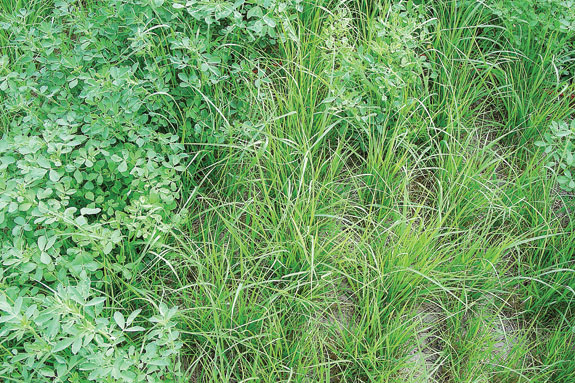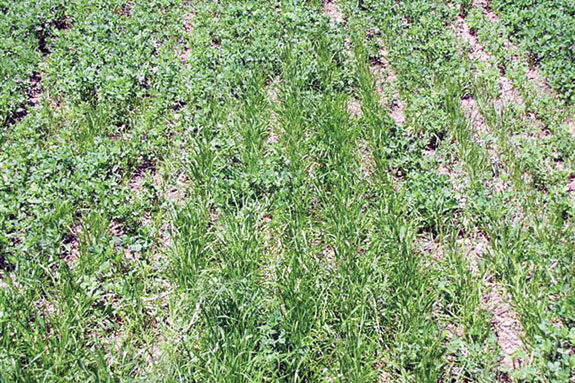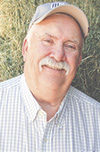The perfect storm of extreme drought conditions in some regions of the country, combined with the low number of new alfalfa hay acres being planted, has severely reduced the supply of hay.
The reduction of national alfalfa hay acres is due in part to the competition for acres with other high-value crops such as corn, wheat and cotton. All of these factors have resulted in a drastic increase in the price of hay.
In this short hay market, the profitability of a hay crop is often determined less on quality but more on actual tonnage, since all classes of hay from low-quality to high-quality are selling out.
In light of these facts, many producers with existing alfalfa hay fields are reconsidering plowing out their older, less productive hayfields and keeping them in for another year or two, hoping to capitalize on the current high hay prices.
However, extending alfalfa fields beyond their normal rotation also carries with it the risk of less-than-optimal yields due to declining stands from disease and/or winter injury.
There are, however, several proven methods available to farmers that can help maintain and/or boost hay production of older fields and extend the production of alfalfa stands for one or more years.
The most obvious means of improving yields of older, declining alfalfa stands is to increase the plant density in the field by establishing new plants into the thin areas of the field.

The following are a few items to consider when interseeding into existing alfalfa fields and the more popular crop options.
At what point is a thin alfalfa field a good candidate for interseeding?
Farmers often ask the question: How thin does an alfalfa stand need to be before it should be rotated out of production or overseeded to extend production?
When farmers first plant new alfalfa stands, they generally plant 15 to 25 pounds of seed per acre. Under good planting practices, this generally results in the desired beginning optimal plant density of around 15 to 25 plants per square foot when measured five to six weeks after planting.
Over time the stand density will thin due to age, diseases, pests, winter injury and/or other agronomic factors.
Forage production usually is considered economical until the plant density per square foot drops below six plants or when the number of stems per square foot drops below 40 to 45.
At that point alfalfa production starts to drop and becomes less profitable. At this point, producers should start to consider terminating the field and rotating into another crop or, in this case, interseeding with another species to maintain and extend production for another year or two.
Successful interseeding into alfalfa stands requires some basic land preparation and planning
As alfalfa fields thin over time, the reduction of plants allows room for weeds to establish. Often the weed pressure in these areas is high enough to make it difficult to interseed a new crop.
Therefore, in some cases, it may be advisable – prior to seeding – that some form of weed control be considered using either mechanical cultivation or a selective weed herbicide.
The height of the alfalfa canopy should also be managed to ensure it doesn’t interfere with the planting and/or establishment of the new seed.
Harvesting the existing alfalfa prior to planting or interseeding into dormant alfalfa are good options that can reduce competition during the establishment period of the new crop species.
Soil fertility is also a consideration before planting, and soil samples should be taken and fertilizer applied as needed.
If grass species are used for interseeding, some consideration should be made as to what fertilizer combinations are used, since fertilizer applications high in nitrogen may favor grasses over legumes and result in a shift of the predominant plant species of alfalfa more towards the grass component.
Can I plant new alfalfa seed into old alfalfa?
Farmers often ask if they can interseed new alfalfa seed into the thin spots of an existing alfalfa field to thicken it up and boost production.
The short answer is that it generally doesn’t work. Planting alfalfa seed into an older alfalfa field normally fails due to a phenomenon called autotoxicity.
Autotoxicity is the situation in which established alfalfa plants produce a toxin that prevents new alfalfa seedlings from germinating, surviving and/or growing.
Therefore, planting new alfalfa seed into thinning older alfalfa fields is generally not considered a viable option for increasing stands and yields.
Common species often used to extend production of thin alfalfa stands
• Legumes
In many parts of the country interseeding another legume into alfalfa is a viable means of thickening up an old alfalfa stand.
This is often done in situations in which forage quality is somewhat more important than achieving higher yields. If dairy-quality hay is needed, adding a legume into the alfalfa stand is a good means of maintaining good-quality hay.
The following are some of the more popular legume interseeding choices: red clover, ladino clover and berseem clover.
• Cool-season grasses
The cool-season grasses can increase forage production early in the season but have less production during the middle of the summer.
One of the most popular cool-season grasses to interseed into alfalfa is orchardgrass, and it is commonly used when the farmer needs several additional years of forage production.
Other popular cool-season grasses are tall fescue, smooth brome and meadow bromegrass.
Another crop gaining attention is intermediate ryegrass, a cross between perennial and Italian ryegrass. This grass has improved yield and quality and is an excellent choice for improving production for two additional seasons.
• Warm-season annual grass
Warm-season annual grasses such as teff grass and sudangrass are excellent one-season interseeding choices for alfalfa fields that have unexpectedly come out of the winter with significant winterkill.
Both grasses have high forage production during the “summer slump” period often associated with cool-season grasses.
Teff grass forage quality is comparable to timothy, making it highly desired by the horse market. Sudangrass works very well in hay production situations due to its smaller stem diameter, which promotes faster drying after cutting.
Planting a warm-season grass into alfalfa is often delayed until after the first alfalfa harvest to ensure soil temperature at planting is optimal for germination (greater than 65 degrees).
• Small grains (oats, beardless barley, triticale, wheat)
Small grains are often used to increase tonnage of a thin alfalfa stand and extend stand life for one season. Forage quality can be good if cut prior to boot stage.
Summary
Numerous interseeding choices are available to farmers wishing to extend the forage production of thin alfalfa stands in order to take advantage of the current hay market.
Low national hay stocks and historic high hay prices make this practice a viable option for increasing profits in the coming year. FG
Click here for more information on dormant seeding.
PHOTO
“Tiffany” teff grass interseeded into alfalfa can extend production of a field that has come out of winter with damage. Photo courtesy of Don Miller.












